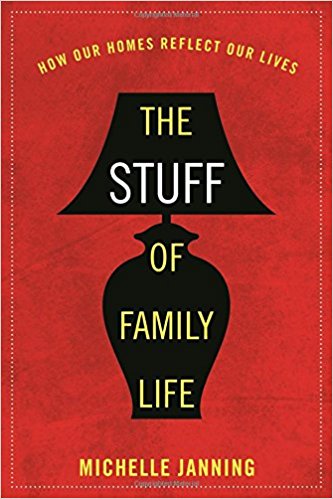I still remember the thrill I got years ago when I finished hanging wall shelves in my bedroom closet. It was the first time I’d actually drilled holes in walls and the first time I’d ever even attempted a home improvement project.

Michelle Janning, author of The Stuff of Family Life: How Our Homes Reflect Our Lives, would, I think, be proud of me. She far outdoes me in terms of remodeling projects — in her book she talks about nailing trim, painting a mural on a garage door, knocking down walls, using a table saw — but she would at least appreciate my tackling a (relatively small) remodeling task. For Janning knows full well that my purchasing and using a drill meant a tiny but culturally significant move from housekeeper to handyman — and our common usage of the term “handyman” should clue you in as to where our society stands on the issue of male vs. female tasks.
Janning is a sociologist, and scholarly research abounds in The Stuff of Family Life. Homes, she writes, “tell us about how family lives are impacted by changing societal roles, cultural views, economics, science and technological innovation, and political trends.”
Sound a bit too academic? Actually, there are a lot of fascinating tidbits here. One chapter, for instance, looks at how college freshmen make careful decisions about the items they put in their new dorm rooms. Would propping a favorite stuffed animal on the bed look too childish? Does that poster properly convey my identity and interests? The stuff in a dorm room speaks volumes about its resident, as the student makes the tricky transformation from child to adult.
And what about those children of divorce who move back and forth from one parent’s house to another? Research cited by Janning makes it clear, for example, that a sofa bed can make a child feel like a guest in a home that is not theirs. “A spot in in one parent’s home that serves a purpose beyond the child’s needs is seen as undesirable,” she writes, adding, “A feeling of permanence, rather than transition, is what the kids want.” But all is not lost for those who simply don’t have the space to set up a separate bedroom for a weekend traveler. Sometimes, she writes, simply having a conversation about the issue would be helpful for both parent and child.
Want to know how family life in the United States has changed over time? Look at today’s houses, many of which feature open floor plans “that make everyone in the house visible, at least when they’re awake, whether they’re cooking, eating, doing homework, paying bills, watching TV, or playing with toys in a playpen in the corner.” Such multiuse, multigenerational spaces, Janning notes, are due in part to “an increased focus on supervision and structuring of children’s time by parents.”
The accompanying movement of kitchens to a more visible location also speaks of a move to a more egalitarian use of the kitchen, as cooking becomes a shared household task.
Of particular interest to me was Janning’s clever question: “If a woman had a hammer, what would it mean?” Unfortunately, I did not inherit my maternal grandfather’s skill at carpentry, so my home improvement projects continue to be minimal. Even if I could complete a major home remodeling project — which might end up as a Pinterest Fail — the research Janning has done reveals that advertisers and TV shows are slow to keep pace with the changes in what society deems appropriate work for women and for men.
It would be a shame if the scholarly underpinnings of The Stuff of Family Life turn readers away, for the book is well-stocked with fun examples and intriguing analyses of how our homes and the stuff within them reveal more than we might have imagined. It’s a fascinating class in social issues, with Janning as a likable teacher.
Carol Schaal is managing editor of Notre Dame Magazine. Email her at schaal.2@nd.edu.